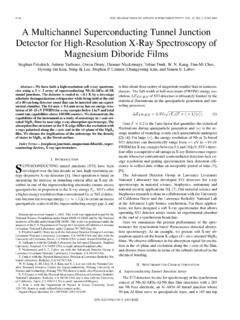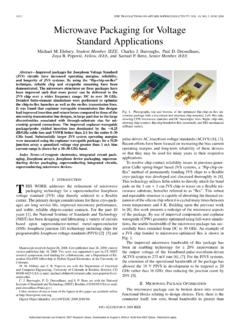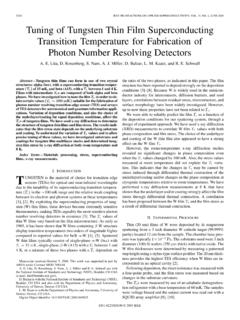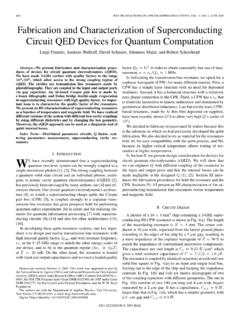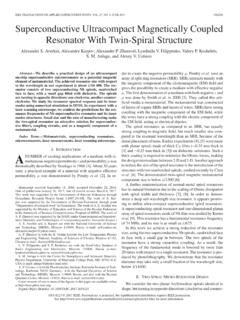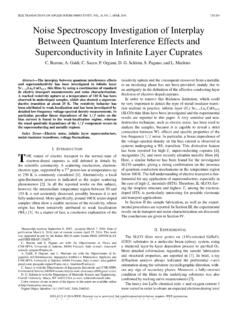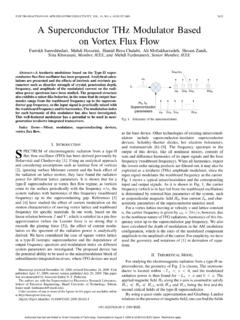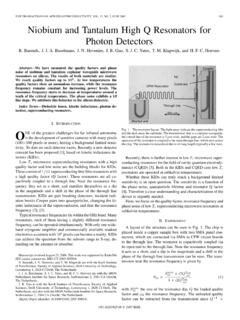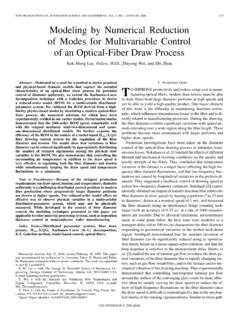Transcription of IEEE TRANSACTIONS ON APPLIED SUPERCONDUCTIVITY 1 …
1 This article has been accepted for inclusion in a future issue of this journal. Content is final as presented, with the exception of TRANSACTIONS ON APPLIED SUPERCONDUCTIVITY1Pb Graphene Pb Josephson Junctions:Characterization in Magnetic FieldI. V. Borzenets, U. C. Coskun, H. Mebrahtu, and G. FinkelsteinAbstract Wefabricatesuperconductor graphene superconductor Josephson junctions with superconductingregions made of lead (Pb). The critical current through graphenemay be modulated by the external magnetic field; the resultingFraunhofer interference pattern shows several periods ofoscillations, suggesting that the junction is uniform. Deviationsfrom the perfect Fraunhofer pattern are observed, and their causeis explained by a simulation that takes into account the Terms Josephson junctions, superconducting devicemeasurements, superconducting films, superconducting materials,superconductor normal superconductor INTRODUCTIONTHEPROPERTIES ofsuperconductor graphene superconductor(SGS)junctionshaveattracte dsignificantattention[1] [5].
2 Unliketheconventionalsuperconductor normal-metal superconductor (SNS) junc-tions, devices made with graphene allow for high tunabilitywith the gate voltage. We have recently reported on SGSjunctions, which use lead (Pb) as the superconducting material[5]. Lead has a relatively high critical temperature of K,as compared with K in the case of the commonly usedaluminum. Indeed, we have observed supercurrent throughgraphene at temperatures as high as 2 K. In this paper, wecharacterize the properties of these junctions by applyingmagnetic SAMPLE ANDMEASUREMENTDESIGNWe fabricate the superconducting contacts to graphene froma palladium/lead (Pd/Pb) bilayer. First, we deposit a 2-nm layerof palladium, which creates transparent contacts to grapheneManuscript received February 27, 2012; revised April 17, 2012 and May 1,2012; accepted May 1, 2012. This paper was recommended by Associate EditorO.
3 Mukhanov. The work was supported by the Division of Materials Sciencesand Engineering, Office of Basic Energy Sciences, Department of Energy,under Award V. Borzenets was with Duke University, Durham, NC 27708 USA C. Coskun was with Duke University, Durham, NC 27708 USA. He iscurrently with the University of Illinois, Urbana-Champagne, Urbana, IL 61801 USA (e-mail: Mebrahtu was with Duke University, Durham, NC 27708 USA. He iscurrently with the Intel Corporation, Santa Clara, CA 95054-1549 USA Finkelstein is with Duke University, Durham, NC 27708 USA versions of one or more of the figures in this paper are available onlineat Object Identifier [6], [7]; a 100-nm layer of lead is depositedin situon lateral width of the contacts is typically 500 nm. In thispaper, we present the results measured on a junction about20 m wide and 400 nm long. (Commonly, the length of thejunction is defined as the distance between the superconductingcontacts and the width as the distance of the normal metal alongthe superconducting contacts.))
4 In order to create such a widejunction, the leads are bent in two places to fit on a moderatelysized graphene flake [see Fig. 1(a)]. We show that this particularsample design has certain nontrivial measured the sample electronic properties using a pseudofour-probe setup [see Fig. 1(a)]. The junction is biased bycurrentI, which contains a small ac component, and the acvoltage across the junction is measured using a lock-in am-plifier. The carrier density in graphene can be tuned by theback-gate voltageVgate, but for the results presented, the gatevoltage is set at zero. Finally, a perpendicular magnetic fieldcan be APPLIED using two methods. Conventionally, fieldBextcan be created by an external solenoid magnet. Alternatively,we send currentILalong one of the superconducting leads [seeFig. 1(a)], inducing a field that we label asBL. The advantageof the second method is that the required small fields can beeasily obtained and rapidly changed.
5 In this sample, we havecalibratedBLto be equal to T/AIL(see details below).III. RESULTSThe Pd/Pb electrodes become superconducting at a tempera-ture of 7 K, and the SGS junctions begin to exhibit enhancedzero-bias conductance at temperatures of 2K,a fully formed supercurrent branch is clearly observed [5].Fig. 1(c) demonstrates the differential conductanceR dV/dIversus the bias currentI(vertical axis) and the magnetic fieldBL(horizontal axis) measured at several temperatures. Thedark areas of the maps in Fig. 1(c) correspond to the regionsof suppressed resistance. The regions are bound by a criticalcurrentI=IC, above which the junction becomes value ofICincreases as the temperature is lowered andsaturates aroundIC A at zero magnetic field [see thelowest map in Fig. 1(c)]. WhenBLis APPLIED ,ICoscillatesin a way closely resembling the Fraunhoffer diffraction pattern[10]. Several oscillations ofICcan be observed at the lowesttemperature; this suggests that the junction is next apply an external magnetic fieldBext, which isfound to shift the modulation pattern of Fig.
6 1(c) in the hori-zontal direction (Fig. 2). The shift is linear inBext; indeed, atthe center of the pattern, the external field and the one inducedbyILcancel each other. The observed rate of the shift allows1051-8223/$ 2012 IEEEThis article has been accepted for inclusion in a future issue of this journal. Content is final as presented, with the exception of TRANSACTIONS ON APPLIED SUPERCONDUCTIVITYFig. 1.(a) Schematic of the measurement setup. The metal leads form a shape in order to increase their length. Bias currentIwith a small acmodulation is sent through the junction. The resulting ac component of thevoltage across the junction is measured using a lock-in amplifier allowing one torecord the differential resistanceR dV/dI. An external magnetic fieldBextis APPLIED by a superconducting solenoid. In addition, a magnetic fieldBLiscreated by sending currentILalong one of the leads of the junction.
7 SweepingcurrentILallows to apply a very small magnetic fieldBL. (b) Scanningelectron micrograph (SEM) of a graphene-based SNS Josephson junctionsimilar but smaller than the one presented in this paper. (Junctions used forthe measurement were not imaged in order to preserve the quality of graphene.)The dark triangular area is a single-layer graphene flake, and the metal contactsare made from lead (Pb) with a thin contact layer of palladium (Pd), whichextends 10 20 nm past the Pb. The image was taken using an FEI XL30 SEM with a ultrahigh resolution TLD detector at the accelerating voltageof 1 kV. (c) Differential resistancedV/dImaps measured versus bias currentIand magnetic-field-inducing currentIL. Regions of vanishingRappeardark. Each panel corresponds to the measurement at a different zero-bias conductance develops around 4 K for small lower temperatures, more and more critical current modulations appear,and the Fraunhofer interference pattern is observed.
8 At the base temperature K, the critical current is seen at fields beyond 5 mT (see Fig. 5). Observingmany oscillations suggest that the junction is highly to fix conversionBL= earlier. Thisfactor is also consistent with our order-of-magnitude , the shift of the pattern by 0in an externalmagnetic field of mT allows us to extract the effective areaof m2. While this area is smaller than 8 m2expectedFig. (I,IL)maps [like those in Fig. 1(c)] measured at different valuesof the external magnetic field (a)Bext= , (b)Bext= ,(c)Bext=0,(d)Bext= , and (e)Bext= Application ofBextshifts the modulation pattern, (b) (d) so that at its centerBextandBLcancel each other. Since the cancellation is not perfect, (a) the pattern getsdistorted, compared with the pattern at the zero external field (c). Oppositeorientation of the external magnetic field (e) results in mirror reversal of the designed sample dimensions ofW=20 mbyL= m, it is quite likely that lengthLbetween the leads isreduced in the process of lithography or that the magnetic fieldis modified due to the presence of the superconducting the magnetic fieldBextof the order of tens of mil-litesla is APPLIED to the sample, the observed pattern becomesdistorted even after the field is returned back to zero (see Fig.)
9 3).It is clear that the resulting pattern atBext=0[see Fig. 3(a)] isvery different from the original one [see Fig. 2(c)]. We can par-tially recover the original pattern by settingBext [seeFig. 3(b)]. When comparing the resulting pattern to the originalone [see Fig. 2(c)], we notice that the critical current is slightlysuppressed and the sidelobes have somewhat random attribute these distortions and the shift from the zero field tothe trapping of magnetic flux in the superconducting film [11],[12]. Indeed, the undistorted pattern shown in Fig. 2(c) can berestored following the thermal cycling to 10 K, beyond thecritical temperature of , at fields less than those causing trapped flux ofFig. 3, distortions of a different nature are introduced to thepattern [see Fig. 2(a)]. The first difference is that, returningThis article has been accepted for inclusion in a future issue of this journal. Content is final as presented, with the exception of al.
10 : PB GRAPHENE PB JOSEPHSON JUNCTIONS: CHARACTERIZATION IN MAGNETIC FIELD3 Fig. (I,IL)measurements taken after the perpendicular magnetic fieldwas ramped beyond several tens of millitesla. (a) Measurement done whenBextwas returned back to zero. Clearly, the pattern is now vastly distorted.(b) Taken atBext= At this field, the original critical current modula-tion pattern [see Fig. 2(c)] is partially restored. However, the central lobe showsa suppressed critical current, and the sidelobes form a distorted pattern. Thesepermanent distortions are attributed to the trapped flux in the leads. Heatingof the sample beyond theTCvalue of Pb is required in order to restore thesymmetric patterns shown in Fig. 2(c).toBext=0restores the original pattern without any hystere-sis. Second, the pattern demonstrates perfect symmetry undersimultaneous reversal of bothBextandIL[cf. Fig. 2(a) and(e)]. We associate this behavior with the fact that the phasedifference is not linear along the length of the leads.


